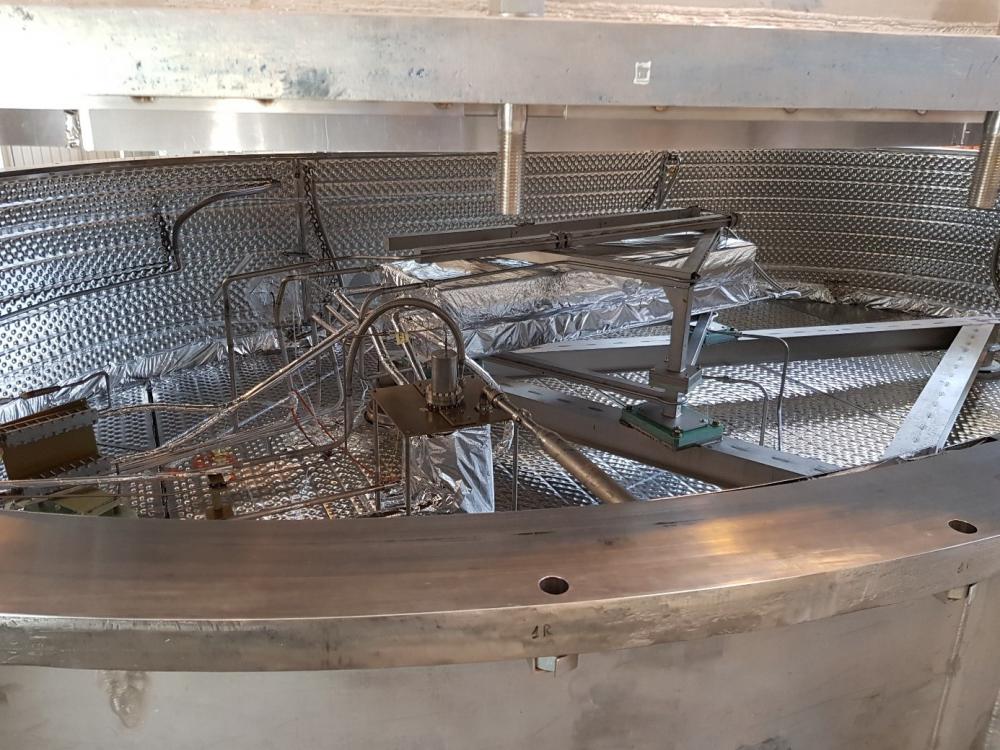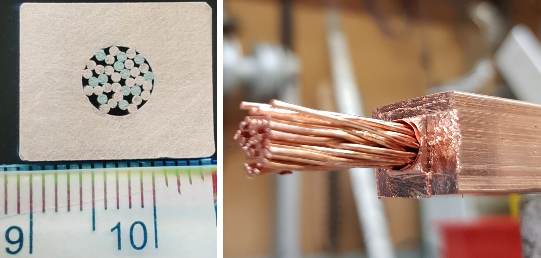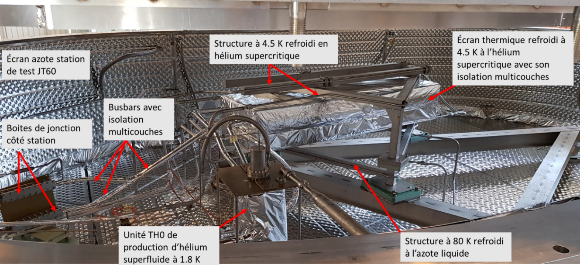
MACQU demonstrator designed, manufactured, integrated and tested between March 2020 and August 2021. (credit CEA)
The MADMAX project, which was launched in November 2016, is led by the Max Planck Institut für Physik in collaboration with several European institutes. The goal of the project is the discovery of axions with a mass of about 100 µeV, potential candidates for dark matter. To detect these axions, it is necessary to develop a specific detector consisting of an electromagnetic signal amplifier and a magnet proportional to the size of the amplifier and delivering a strong magnetic field. In order to validate the innovations in the fabrication of the magnet conductor, its cooling concept and the quench detection, a demonstrator has been designed, fabricated, integrated and tested between March 2020 and August 2021. It is named MACQU for MADMAX Coil for Quench Understanding. The entire design, from the conductor to the support structure, including the MACQU magnet, its thermal shield and the busbars, was carried out at the CEA. The demonstrator, manufactured by the industrial Bilfinger Noell GmbH, arrived in March 2021 and was successfully tested between May 18 and August 27, 2021. The analysis of the data now completed provides the desired answers and opens up unexpected new avenues of work. The feasibility of the cable concept, its cooling as well as the quench detection for the MADMAX magnet was demonstrated during these tests.
The MADMAX project was launched in November 2016 and is led by the Max Planck Institut für Physik in collaboration with several European institutes. The objective of the project is the discovery of axions with a mass of about 100 µeV, potential candidates for dark matter, having to meet CP violation (matter/antimatter imbalance). The realization of this objective requires the development of a dedicated detector constituted by an amplifier of the electromagnetic signal corresponding to the photons (wave-corpuscle duality) induced by the conversion of the said axions. This amplifier, called dielectric haloscope, is itself made of 80 disks of 1.25 m diameter whose positioning must be ensured very finely by piezoelectric motors operating under strong magnetic fields. The haloscope must be bathed in a strong dipolar magnetic field because the power of the amplified signal is proportional to the square of the magnetic field. Moreover, the power of the signal is also proportional to the size of the amplifier, hence the size of the dielectric disks of 1.25 m in diameter, which requires a strong R&D in parallel with the development of the magnet (the state of the art is currently limited to ~30 cm in diameter). Thus, the development of a giant dipole magnet producing a magnetic field of ~9 T in an opening of 1.35 m is necessary (Figure 1). Thanks to its expertise in this field CEA IRFU was selected, in November 2017, in the framework of an innovation partnership to design this magnet with the industrialist Bilfinger Noell GmbH.

Figure 2. Cable-In-Conduit Conductor (CICC) type conductor for the MACQU demonstrator magnet. This conductor is made up of 36 strands braided together then wrapped with copper tape and inserted into a rectangular section copper conduit. The 36 strands are one third in superconducting material (Nb-Ti) and two thirds in copper.
In the development strategy for the MADMAX magnet, set up by the CEA IRFU, several demonstrators must be designed in order to mitigate the various risks identified. The first level of risk concerns the conductor of the MADMAX magnet and its behavior in the event of a quench (the sudden passage of the magnet from the superconducting state to the resistive state which can lead to a degradation of the magnet). Indeed, due to market constraints, the CEA IRFU team had to define a new conductor concept for the MADMAX magnet. This concept uses the so-called “cable in conduit” structure of fusion magnets while using a copper conduit instead of a stainless steel conduit (Figure 2). In addition, the cooling of the conductor is not standard for this technology because it is achieved by filling the conduit with superfluid stagnant helium at 1.9 K rather than by a forced circulation of supercritical helium at 4.5 K as for fusion magnets. These few kelvins of difference make it possible to increase the magnetic field of the magnet and thus its performance. These novelties, at the level of the conductor, questioned the feasibility of quench detection and therefore the protection of the magnet.
In order to validate the manufacture of the conductor, its cooling concept and the detection of the quench, a demonstrator was designed, manufactured, integrated and tested between March 2020 and August 2021. It is called MACQU for MADMAX Coil for Quench Understanding (Figure 3) . The entire design, from the conductor to the support structure, including the MACQU magnet, its heat shield and the busbars, was carried out at the CEA. The conductor was manufactured by ASIPP (Institute of Plasma Physics, Chinese Academy of Science), then sent for the manufacture of the MACQU magnet to Bilfinger Noell GmbH, also in charge of the invoice for the support structure, the heat shield and busbars.

Figure 3. Upper part: CAD of solenoid magnet or MACQU solenoid. Lower part: CAD of the assembly with the MACQU magnet cooled via the conductor with superfluid helium at 1.9 K, its support and thermalization structure (bottom in pink cooled at 80 K with liquid nitrogen, top in blue cooled to 4.5 K with supercritical helium) and its heat shield also cooled with supercritical helium at 4.5 K. Certain parts of the heat shield (removed here) are removable to facilitate integration of the magnet by giving access to the solenoid from above or to the junction boxes on the front face.

Figure 4. MACQU magnet integrated into the JT60 test station and ready for the test campaign once the cryostat is closed, vacuum-pumped and the operating temperature of 1.9 K is reached in the MACQU magnet.
The magnet was received in Saclay in March 2021 to prepare for its integration into the JT60 test station then in place in building 126. The JT60 station had previously been modified to accommodate the magnet. Indeed, a superfluid helium production unit, named TH0, had been installed there. The quench detection/magnet protection system (MSS: Magnet Safety System) had been restructured to meet the needs of the MACQU experiment and the station's piloting automata adapted to the new configuration of the experiment. This work was entirely carried out by the DACM and DIS teams from IRFU. Upon receipt of the magnet, the work mainly focused on the production of the junction boxes of the MACQU magnet allowing the decoupling between the electrical and hydraulic circuit of the conductor at the ends of the magnet, the finalization of the instrumentation in front of allow the study of the propagation of the quench as well as the placement of the bubars (Figure 4).
The test campaign began on May 18 and ended successfully on August 27, 2021, providing the desired answers and opening up unexpected new avenues of work on the design of junction boxes, for example. The proof of concept of the cable and its cooling was demonstrated during these tests. With about sixty quenches detected on MACQU, the risk of a MADMAX magnet protection fault has been ruled out. The thermo-hydraulic behavior of the quench could be studied in greater detail and it was demonstrated for the first time that the phenomenon of thermo-hydraulic quench back also took place in superfluid helium (Figure 5). This phenomenon accelerates the quench because preheating by isenthalpic expansion of the helium in the conductor downstream of the quench ends up reducing the temperature margin of the conductor. This small margin de facto reduces the heating time to reach the critical temperature of the conductor at the level of the quench front and thus the latter accelerates.

Figure 5. Measurements of the quench propagation speed within the MACQU conductor at different current levels. The initial velocities extracted from these measurements prove that the quench is fast enough to develop a detectable voltage at the terminals of the magnet allowing it to be protected. The break represents the acceleration due to the thermo-hydraulic quench-back observed for the first time in superfluid helium!
Contacts: LORIN Clément; ABDEL MAKSOUD Walid
References:
[1] MADMAX collaboration, “A new experimental approach to probe QCD axion dark matter in the mass range above 40 µeV” Eur. Phys. J. C (2019) 79: 186
[2] U. Durañona, W. Abdel-Maksoud, B. Baudouy et al., “Design of a magnet to study quench propagation in a Cable-In-Conduit-Conductor filled with stagnant superfluid helium” Cryogenics, vol. 125, 103499 (2022)
[3] C. Lorin, W. Abdel Maksoud et al, “Development, Integration, and Test of the MACQU Demo Coil Toward MADMAX Quench Analysis”, IEEE Transactions on Applied Superconductivity, 2023, https://ieeexplore.ieee.org/abstract/document/10120974
[4] F. Stacchi, C. Berriaud et al., “Conductor Qualification and Fabrication for the MACQU Solenoid”, IEEE Transactions on Applied Superconductivity, 2023, https://ieeexplore.ieee.org/abstract/document/10158365
[5] T. Pontarollo et al., “Cryogenic design of a superconducting magnet with a copper cable-in-conduit conductor filled with static superfluid helium”, IEEE Transactions on Applied Superconductivity, 2023, https://ieeexplore.ieee.org/abstract/document/10232872
[6] W. Abdel-Maksoud, U. Durañona, B. Baudouy et al., “Thermohydraulic Quench Back in a Copper CICC Coil Cooled by He II”, IEEE Transactions on Applied Superconductivity, 2023, ???????https://ieeexplore.ieee.org/abstract/document/10230847
• superconducting magnet physics and technology › Instrumentation and development for R&D magnets superconducting magnet physics and technology › Superconducting Magnets for Particle Physics Research Technological platforms › Development, integration and test platform for accelerators and superconducting magnets: Synergium Accelerator physics and technology
• Accelerators, Cryogenics and Magnetism Division (DACM) • Institute of Research into the Fundamental Laws of the Universe • The Systems Engineering Division
• LCSE • LEAS • Design, studies and preliminary projects laboratory (LCAP)
